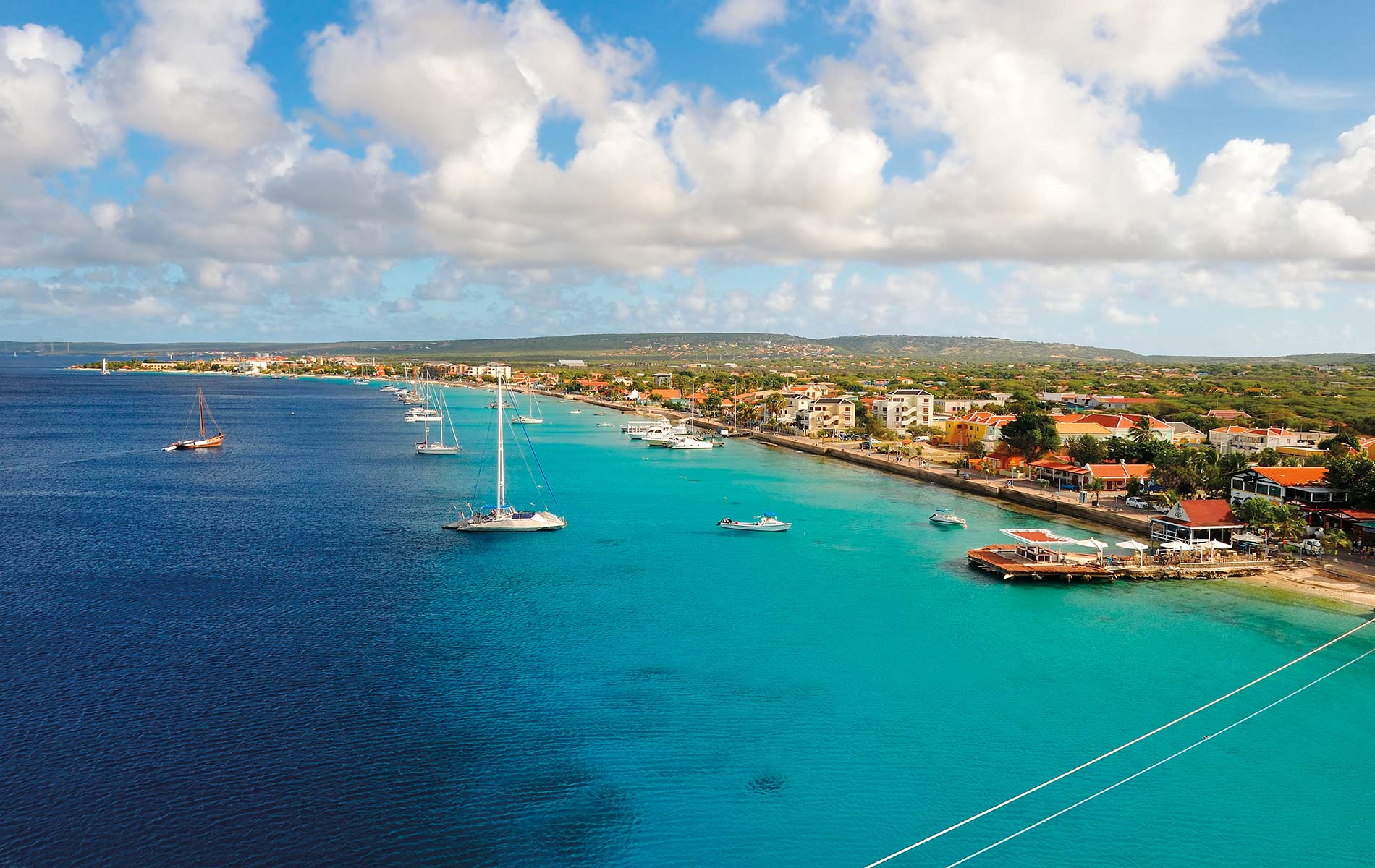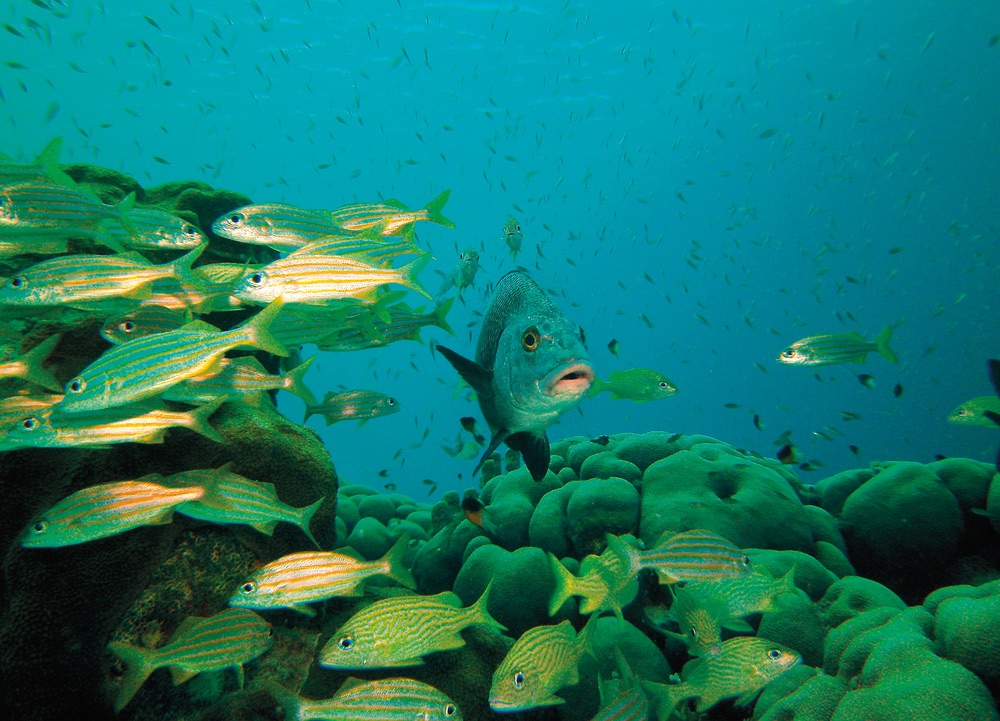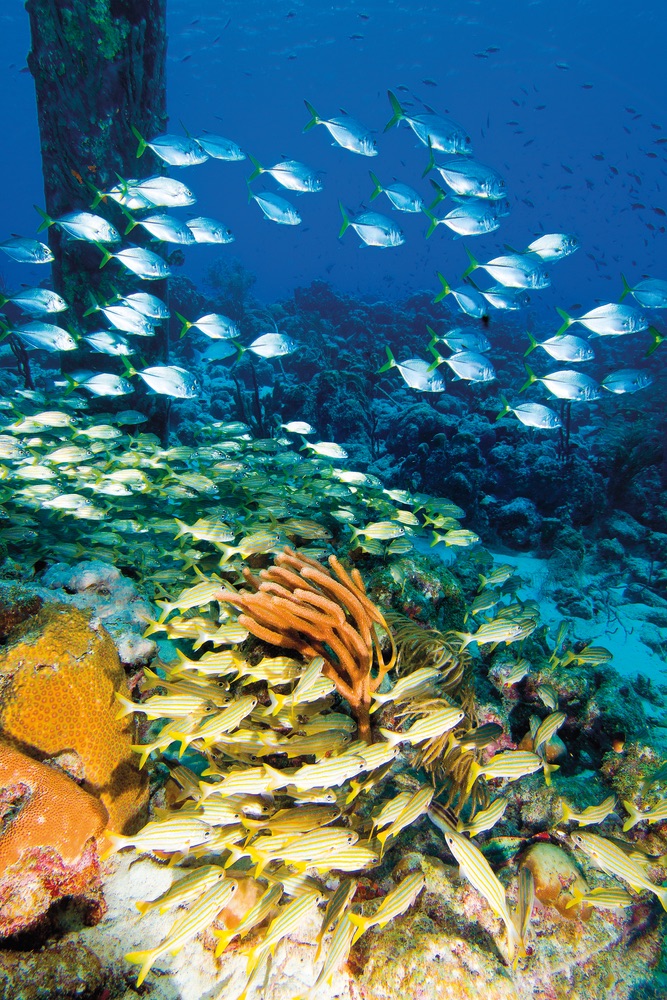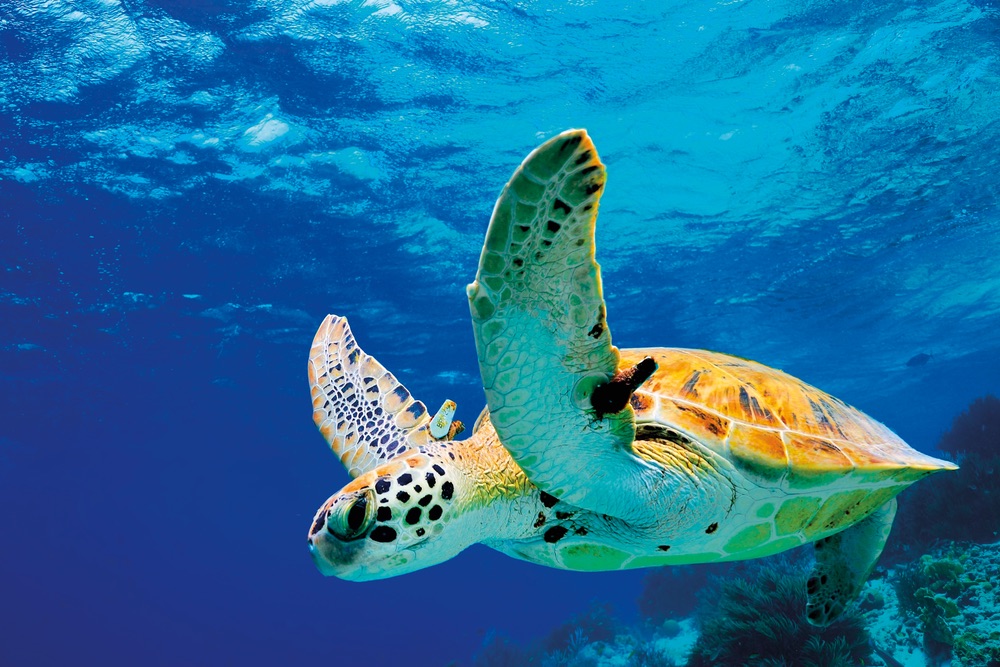
vie-magazine-bonaire-hero
Underwater Wonderland
Behold the Beauty of Bonaire
By Anne W. Schultz
On the outer wall of a tall building, a colorful mural of tropical fish and other marine life attracts the attention of motorists driving down the coastal highway on Bonaire, a small Dutch island located in the southern Caribbean about fifty miles north of Venezuela. A Scripture verse from Psalm 107 written at the bottom, “Behold the wonders of the deep,” encourages travelers to plunge in and take a look. Right off the highway, long probing fingers of sunlight illuminate these wonders for divers and snorkelers who are doing just that at one of the eighty-six shoreline dive sites along the fringing reef that rings the island. Suspended and weightless, they float transfixed by the scene below.
The underwater paradise they view remained undiscovered until 1962, when, according to a 2016 article in Bonaire Affair, Captain Don Stewart, a diver from California, sailed in and noticed “coral gardens the likes of which I had never seen before.” He recognized the untapped potential for a diving industry, so he decided to stay and help pioneer it. He started the first dive operation on the island and encouraged the government to ban spearfishing. That resulted in some of the friendliest fish around flourishing in a population of over three hundred and forty species.
He started the first dive operation on the island and encouraged the government to ban spearfishing.
Bonaire stood at the crossroads at a time when tourism was escalating in the Caribbean. The island could either follow the lead of some other Caribbean islands that chose the tourist dollar over conservation or take a less-traveled, more conscientious path. The decision of an enlightened government and a conservation-minded diving industry to create the Bonaire Marine Park in 1979 transformed a sleepy island into the best diving destination in the Western Hemisphere.
Bonaire was the first in the Caribbean to protect an entire island. The park extends from the high-water mark to a two-hundred-foot depth and encompasses the entire coast, including the deserted offshore island of Klein Bonaire and Lac Bay, an inland bay. Conservation has paid off. Stringent rules have resulted in the healthiest coral reef in the Caribbean and the sheltering of around fifty-five species of coral. These conservation policies assure a rosy future for Bonaire as divers keep coming back year after year.
Out of the many languages spoken on Bonaire, the French word extraordinaire best expresses how divers feel about Bonaire’s diving conditions. Calm waters with warm temperatures provide safe and easy conditions for all ages. Without inland rivers to muddy the clarity with sediment, visibility extends to a hundred feet in the clearest water in the Caribbean. Twenty-four miles of protected leeward shoreline are due to the boomerang-shaped island’s unique north-to-south orientation. It looks like the entire island is designed as a diver’s nirvana, with its fringing reef so close you can walk right in.
“Go exploring. Drive around the island and pull over at the yellow rocks placed along the highway to find your favorite site,” my cousin Susie Schmidt says. We have the inside scoop, as Susie and husband John have lived here for five years and they know the territory. Formerly from Washington, D.C., the couple led groups to exotic diving destinations around the globe for thirty years until their daughter Tina married a Dutchman in Bonaire, and they moved down to be with her. The couple works at Buddy’s Dive Resort, helping visitors take underwater photos in a responsible way that doesn’t harm reefs.
Since I hadn’t seen my cousin in ages, I decided it was high time to plan a holiday with my husband, Bill, and daughter Alison and get reacquainted. Now we could see what these veteran divers had been raving about all these years. We started right outside the house we rented in the upscale Sabadeco neighborhood where we could climb down a ladder and slip right in.
Lifted high and held by crystalline water, we flutter kick along the surface while looking down at another universe. We become voyagers beholding the wonders of an uncharted kingdom with enchanted coral gardens in muted colors like soft rose, velvety greens, delicate blues, and lavender spreading life and beauty across the floor of the sea.
Some corals branch like land cacti, others fan out, and some clump together like bushes. Soft, feathery corals wave like ferns fluttering in a breeze. Brain corals resemble round boulders. Leafy-looking corals rise in thick columns, while hollow tubular shapes look sculpted as if on a potter’s wheel. It’s hard to believe corals are actually colonies of invertebrate animals enmeshed in a symbiotic relationship with algae. We hear crunching underwater as a parrotfish nibbles coral to extract the algae.
The swirling tropical fish flash a kaleidoscope of blazing incandescent colors against the cool blues. It looks like the pulsating colors of the tropics have been washed across the luminous scaled bodies of fish to brighten up the deep. The blazing yellow of the equatorial sun pops off many of them as they dart past. The glowing corals and purplish hues of a sunset are drawn in lines and squares, and the iridescent colors of an island rainbow are stippled across a parrotfish tail. I notice another radiant shade of yellow that reminds me of local birds, like the orioles singing in the trees outside our window or the bananaquit that built a nest on an outdoor light fixture.
The splashy colors, the intricate designs, the perfection of details like a perfectly rounded polka dot, a precisely drawn stripe, or a geometric plaid decorating these tropical fish reveal a loving Creator highly invested in His creations.
The way the word behold is used in Scripture implies a deeper way of seeing, a spiritual awakening that comprehends the glory of God reflected all around us in the natural world. The splashy colors, the intricate designs, the perfection of details like a perfectly rounded polka dot, a precisely drawn stripe, or a geometric plaid decorating these tropical fish reveal a loving Creator highly invested in His creations. These gussied-up, flamboyant fish also display the playful, whimsical side of God. But His glory cannot be clearly discerned if the reef is degraded.
So in 2008, when Hurricane Omar hit—a highly unusual event, as Bonaire lies south of the hurricane zone—and damaged reefs on the northern and western shores where Buddy’s Dive Resort is, a team at Buddy’s sprang into action. In 2012 they partnered with the Coral Restoration Foundation USA (CRF USA for short) and became part of one of the most extensive restoration projects in the Caribbean.
CRF Bonaire is dedicated to restoring Bonaire reefs by growing staghorn and elkhorn corals in large nurseries and later transplanting them to degraded reefs. You can see one of the nurseries in the shallow waters at Buddy’s Reef, where corals are growing on tree-like structures lined up in rows. Locals and visiting divers support the project financially and by volunteering. These dedicated, trained divers clean, rehang, and prune the corals until they’re sturdy and large enough to transplant. At the latest count, nine thousand corals are growing while eight thousand have already been transplanted, showing what can be accomplished when people unite in a common cause. As Elizabeth, one of those volunteers, puts it, “We come from all over the world, we get along, we work together, and we get things done.”
You don’t need to stay dripping wet and submerged to behold the wonders of Bonaire, as more spread across the landscape of the 112-square-mile island formed from an ancient coral reef. Begin at the flat southern tip where the Dutch once mined salt for preserving the herring they traded during colonial times. Stop by the Mangrove Info Center at Lac Bay, where you can arrange a kayak tour and learn that what happens on land affects coral reefs.
Mangroves protect against erosion, filter nutrients from the water, and produce organic acids vital to the robust health of coral reefs. They provide sanctuary for wetland birds and also provide nurseries for fish and invertebrates that later populate the reefs. Lac Bay is a Ramsar site, which means it is recognized worldwide for the global significance of its wetlands. Indigenous people from Venezuela (Bonaire’s earliest inhabitants) arrived around 1,500 years ago and settled around the bay for its supply of fish and shellfish.
The most important breeding ground for the southern Caribbean flamingo is found in this southern region. Their shocking-pink plumage pops against the water, where they can be observed from the highway with heads submerged while foraging. Bountiful sea grasses and jellyfish attract sea turtles. Conservation protects sea turtles on Bonaire; three of the world’s six endangered species are found there: the green, the hawksbill, and the loggerhead.
Rent a four-wheel drive vehicle for touring the rutted dirt roads of Washington Slagbaai National Park located in the northern section. Arid, dry, and windy, this mountainous region with its rare dry forest resembles Arizona. Cacti and aloe plants grow among twisted trees like mesquite and acacia, their branches fortified with sharp thorns. The forest shelters some of the 203 bird species sighted and some rare ones like the yellow-shouldered Amazon parrot. A long drive takes you around the park where you can hike trails or ride mountain bikes—passing scenic lakes, limestone cliffs, and crashing waters—and encounter still more flamingos.
If the siren song of the sea still calls, catch a water taxi to Klein Bonaire, where you have the island to yourself unless a cruise ship is in town. It’s one of the last untouched islands of its size in the Caribbean, with the soft white sandy beach for strolling and reefs offshore for snorkeling. If rainy days prevent outdoor activities, visit the new Terramar Museum, a historical and archaeological museum located in one of the few remaining historical buildings in the center of Kralendijk, the main town.
Explore the entire island and discover that with its stunning natural beauty and international influences, Bonaire is a small island that lives large. While embracing big ideas about conservation, Bonaire ensures there will always be glorious wonders to behold.
— V —
Share This Story!
KEEP UP WITH THE LATEST STORIES FROM VIE



















































































































































